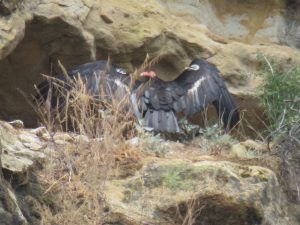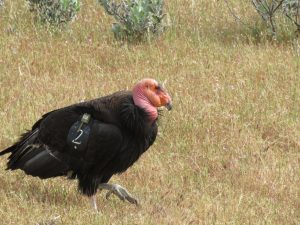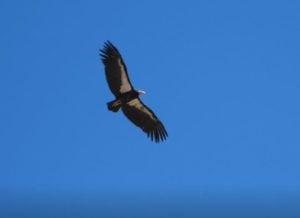Flight of the Condors
By Taylor Crisologo
The air was cool and crisp. It was just before sunrise, so you could begin to see swatches of color painting the sky. On the horizon, the twisting curves of the mountains were beginning to be illuminated. We were the only ones awake at this hour in the small motel. Our bags packed, we walked outside into the dawn.
I’ve been a birder since my first months in college. There, I discovered a community of people that were just as in love with nature as I was. I reveled in studying new field guides and visiting new places with unfamiliar habitats to discover and explore. Thus, my journey as a birder and conservation devotee led me to Pinnacles National Park this February morning to look for California condors.
With wingspans over 9 feet, the California condor is North America’s largest bird. As scavengers, they rely on animals that are already dead for food. But the food that they scavenge is not always safe: hunters often use lead ammunition, resulting in carrion that is lead-tainted. Condors that eat carrion such as this are subject to the effects of lead poisoning, which ultimately leads to death.

Lead poisoning and other threats (such as habitat loss and hunting) resulted in only 22 wild birds remaining in 1982. As lead poisoning threatened to kill the few wild condors left, efforts were mobilized to capture the last individuals in the wild for captive breeding programs. Since the last wild condor was captured in 1987, the species has been slowly increasing in numbers. Today, there are over 440 individuals total, both in captivity and released into the wild.
We drove slowly through the entrance of the park, arriving just as they opened the gates. Pulling into a spot in a nearly-empty lot, we grabbed our packs and set off on the trail. I clutched my binoculars nervously, fidgeting with the focus. We headed slowly down the path, our necks craned up to scan the skies. Turkey vulture. Red-tailed hawk. Two turkey vultures.
We had only been on the trail for 15 minutes when Dan grabbed my arm. “Large white wing patches”, he breathed with one hand still firmly on his binoculars. My hands shot to my own binoculars, bringing them quickly up to the sky to look up at the same area. There they were. Two individuals soared gracefully, illuminated by the morning light. We remained watching, making our birder’s acquaintance with a bird as regal as a monarch.

Today, Pinnacles National Park is the only area governed by the National Park Service that releases captively-bred California condors. The condors, who come from breeding programs at the Los Angeles Zoo, the San Diego Zoo Safari Park, the Oregon Zoo, and the World Center for Birds of Prey (Peregrine Fund), are released at the park when they are around 1.5 years old. Before their complete release into the wild, the young birds are monitored in pens with adult birds. The adult birds serve as “tutors” to the younger birds, teaching them the condor social skills needed in the wild. There are just over 30 California condors living at Pinnacles National Park today.
Despite the conservation successes, our peaceful co-existence with California condors is still questioned. In February 2003, one of the last condors born in the wild was shot and killed during a hunting event. The individual, a female named “AC-8” (AC being an abbreviation for adult condor), played a critical role in the species’ recovery. In her lifetime, she hatched numerous chicks and served as a tutor to young condors entering the wild. In a similar event as recently as 2017, a juvenile California condor individual was shot by a hunter. Stories such as these are a solemn reminder of how the fate of the condors is deeply woven with the actions of humans.

Our biggest threat to the California condors today remains the harmful substances that they are ingesting through carrion. Using field markers to discern individuals, biologists capture and check each bird’s lead levels twice per year. This arduous process is required as lead ammunition remains a persistent risk.
A ban on lead ammunition in California signed in 2013 provides hope that hunting with lead ammunition will disappear in California by 2019. Signed by Governor Jerry Brown, the ban makes California the first state to adopt such regulations. While the ban does not prohibit the purchase of lead ammunition specifically for target shooting, this is a win for our state. Despite this victory, similar bans are still needed nationwide to protect condors and other scavengers outside of California. In short, public awareness, education, and research are still critical to ensure that condors have a safe environment to recover.
Watching the condors soar hundreds of feet above me, I stood in awe. While their story is one marked with great sadness and loss, it is also one lined with hope for recovery.

The condors continued to fly, reaching new heights by the minute.
To see Richard Niedhardt’s short clip of condors in flight click here.
Taylor Crisologo lives in the South Bay, where she avidly birds and runs a site on Bay Area nature (www.bayareanaturalist.com). She studied biology at Cornell University, where she worked with the Cornell Lab of Ornithology on projects ranging from breeding herring gulls off the coast of Maine to dancing lyrebirds in Australia’s Blue Mountains.
